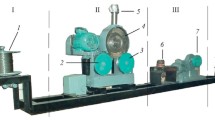Abstract
Mastering the production of high-carbon wire rod — especially cord-grade wire rod — on a mini-complex originally built at the Moldavian Metallurgical Plant to make ordinary wire rod was a daunting problem that has been solved by a collaboration with the Ukrainian Academy of Science’s Institute of Metallurgy. Researchers developed an integrated technology for making the steel, continuous-cast semifinished products, and wire rod needed to make metal cord of ordinary, high, and ultrahigh strength. The wire rod is characterized by a good-quality surface (defect depth no greater than 0.15 mm, with 95% being no deeper than 0.10 mm), good deformability, and the ease with which it can be converted into wire, strands, and cord structures.
Similar content being viewed by others
References
V. V. Parusov, A. M. Nesterenko, A. B. Sychkov, and O. V. Parusov, “Development of the principles and successful introduction of an integrated technology for making wire rod from carbon steel at the Moldavian Metallurgical Plant,” Metallurg. Gornorud. Promst., No. 8–9, 302–306 (2002).
V. V. Parusov, A. I. Vilipp, and A. B. Sychkov, “Effect of impurity elements on the quality of carbon wire rod,” Stal’, No. 12, 53–55 (2002).
H. J. Goldstadt, Interstitial Alloys [Russian translation], Mir, Mosow (1971).
G. V. Samsonov (ed.), Properties of the Elements [in Russian], Metallurgiya, Moscow (1976), Part 1.
R. Kahn (ed.), Physical Metallurgy. Vol 1. Atomic Structure of Metals and Alloys [Russian translation], Mir, Moscow (1967).
A. M. Nesterenko and A. B. Sychkov, “Dimensional-geometric aspects of the alloying of steel with boron and copper,” in: Fundamental and Applied Problems of Ferrous Metallurgy: Symposium, Vizion, Dnepropetrovsk (2004), Vol. 7, pp. 181–183.
L. I. Mirkin, x-Ray Inspection of Materials Used in Machine Construction: Handbook [in Russian], Mashinostroenie, Moscow (1979).
S. I. Gubenko, Transformation of Nonmetallic Inclusions in Steel [in Russian], Metallurgiya, Moscow (1991).
D. A. Dyudkin, “Aspects of the overall effect of calcium on the properties of liquid and solid steel,” Stal’, No. 1, 20–28 (1999).
V. V. Parusov, A. N. Sav’yuk, A. B. Sychkov, et al., “Study of the feasibility of removing most of the scale from the surface of wire rod before drawing,” Metallurg, No. 6, 69–72 (2004).
V. V. Parusov, A. B. Sychkov, M. A. Zhigaev, and A. V. Perchatkin, “Formation of the optimum microstructure in high-carbon wire rod,” Stal’, No. 1, 82–85 (2005).
Kh. N. Belalov, “Formation of the properties of rope wire,” in: Steel Cables, Astroprint, Odessa (2001), pp. 105–116.
Author information
Authors and Affiliations
Additional information
__________
Translated from Metallurg, No. 11, pp. 45–51, November, 2005.
Rights and permissions
About this article
Cite this article
Parusov, V.V., Derevyanchenko, I.V., Sychkov, A.B. et al. Ensuring high quality indices for the wire rod used to make metal cord. Metallurgist 49, 439–448 (2005). https://doi.org/10.1007/s11015-006-0020-y
Issue Date:
DOI: https://doi.org/10.1007/s11015-006-0020-y




